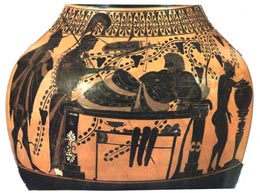Herakles - Introduction

Herakles banqueting on the Olympus
(from 6th c. BC Greek pottery)
Probably the most celebrated hero of classical mythology, Herakles, despite his "merely semi-divine" origins, outshined many of the Olympic deities in terms of popularity and importance. It is somewhat curious that his deeds of bravery and chivalry were somehow destined to survive even the Christian revolution, which, with its emphasis on chastity and disdain for the bodily and all physical, quickly dispensed with most classical celebrities and their values.
Indeed, Herakles (sometimes transliterated as Heracles, and better known in English by the Romanized name of Hercules) had his star shine throughout the Antiquity, on through the Medieval era, and to this day (and not only in simplified Disney movies). Numerous cities and even dynasties of the ancient world had some form of special veneration for Herakles or were named after him. Alexander the Great was immensely inspired by the hero, as evidenced by his coinage, and echoes of that are to be found well into the Middle Ages; numerous Roman emperors did so as well, like Maximianus and the Herculian dynasty of the early 4th century.
For that much of a man and fame, Herakles had to have had an eventful life, and indeed it seems so - his heroics start right from the crib, where he had to deal with nasty snakes sent by his jealous stepmother Hera, through his famous 12 labors, onto fighting at Troy, joining the Argonauts in their quest for the Golden Fleece, and more. Most of these topics are not easily found on coins, but when so, they are typically impressive and refreshing.
